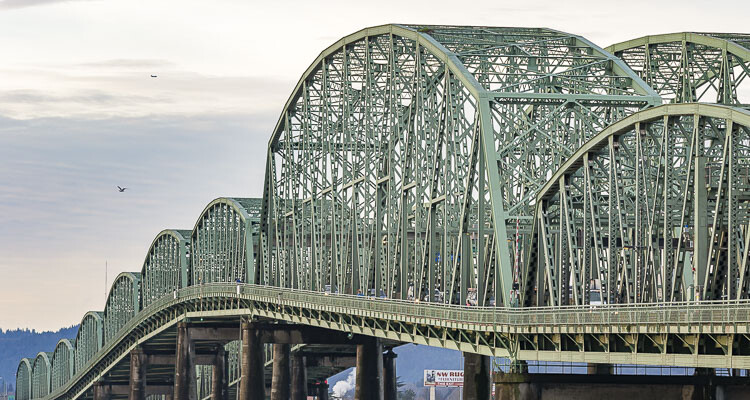
Joe Cortright believes the cost of the I-5 Bridge replacement could be brought down substantially
Joe Cortright
City Observatory
The “bridge replacement” part of the Interstate Bridge Replacement only costs $500 million, according to new project documents

So why is the overall project budget $7.5 billion?
Short answer: This is really a massive freeway-widening project, spanning five miles and seven intersections, not a “bridge replacement”
Longer (and taller) answer: The plan to build half-mile long elevated viaducts on both sides of the river, and the need to have interchanges raised high into the air make the project vastly more complex and expensive.
In November of 2022, the Interstate Bridge Replacement team (a collaboration of the Oregon and Washington highway departments), released a document called the “River Crossing Option Comparison” sketching out the advantages and disadvantages of several different alternatives crossing the Columbia River. The alternatives examined included tunnels under the river, and a series of bridge designs — two different moveable span bridges, and two fixed spans, a high level and mid-level (116 foot clearance crossing.)
Here’s the bottom line of the report — buried away on page 50 of a 68-page PDF file — the IBR’s preferred design, a mid-level fixed span, is supposed to cost $500 million.

That’s a fascinating number, because in December, the IBR team released another document, a long-awaited financial plan describing the total cost of the project. It told a joint committee of legislators from Oregon and Washington that the project’s budget had increased from a maximum of $4.8 billion (estimated in 2020) to a new “maximum” of $7.5 billion (although the two agencies still maintain that they’re trying to bring it in for a mere $6 billion).

All this raises a fascinating question: Why does this project cost $7.5 billion when the price tag for actually replacing the bridge is only $500 million?
Most of the project cost is highway widening, not the bridge
More recently, the project has offered a few additional details, summarized in the graphic below. As we’ve noted at City Observatory, the name “bridge replacement project” is clearly misleading. The IBR is really a five-mile long freeway widening project that requires rebuilding seven closely spaced interchanges. According to the IBR, the cost of the four major segments of the project is about 1 to $1.5 billion each for the Oregon and Washington interchanges and highway widenings (segments A and D), about 1.3 to $2 billion for the transit portion of the project, and about 1.6 to 2.5 billion for the bridge and approaches (segment C).

At between $2 and $3 billion, it’s clear that the interchange rebuilding and roadway widening is more expensive than the river crossing. An earlier expert review of the Columbia River Crossing version of this same project, commissioned by the two state highway departments and the behest of the then Governors, recommended strongly that the project eliminate one or more interchanges, to save cost, improve safety and performance, and enable a better bridge design. By rebuilding these too closely spaced interchanges, the panel warned, the DOTs were repeating – at enormous cost – a decades old design error..
A high bridge requires long, steep approaches
The IBR budget breakdown unhelpfully combines the cost of the “bridge” and its “approaches.” What IBR calls the combined “bridge and approaches” — shown in red — extend for about a half a mile on either side of the river: to Evergreen Boulevard (more than half a mile north of the riverbank on the Vancouver side of the river, and almost all the way across Hayden Island (a bit less than half a mile) on the Oregon side of the river.
We know from the “River Crossing Options” report that the actual bridge itself — that is the portion between the north and south river banks — would cost approximately $500 million to build. What the IBR doesn’t talk about is the “approaches” which are actually elevated viaducts that have to reach 100 feet or more into the air in order to connect to the high level crossing. These are vastly higher (and wider) than the existing bridge approaches, which are fully at grade on the Oregon and Washington sides of the river with the current low-level lift bridge.
The mile of elevated freeway that IBR plans to build to connect its high level bridge to the existing freeway at either end of the red-shaded area is what is driving the cost of this segment of the project. If, as IBR says, the bridge structure costs $500 million, this means that most of the cost of this part of the project — as much as $1.5 to $2.0 billion — are the lengthy, elevated approaches. What IBR has failed to do is consider how much less expensive the approaches could be if it chose one of the alternate bridge designs (either a moveable span or immersed tube tunnel). Either of these designs would allow approaches to be built mostly or entirely at grade, eliminating the expense and environmental impact of elevated viaducts. The lower level would also greatly simplify and reduce the expense of the SR 14 interchange, which currently involves convoluted spiral ramps with grades of 6 or 7 percent.
It’s also worth noting that the IBR project hasn’t itemized the cost of demolishing the existing I-5 bridges. Because these structures cross over sensitive river habitat, and because the bridges themselves have toxic lead paint and other environmental contaminants, the cost of bridge removal could be enormous.
Engineers gone wild, said then-Congressman DeFazio
Clearly, what’s going on here is that highway engineers at ODOT and WSDOT see this project as their opportunity to build the project of their dreams. Not just a giant bridge, but massive new interchanges, wider freeway lanes, and if people insist, a short light-rail extension. The bigger, the better. The grandiose and costly bias of the state highway departments has been long known to key local leaders. Former Congressman Peter DeFazio (until last year, Chair of the House Infrastructure Committee), in a characteristically frank admission told The Oregonian:
“I kept on telling the project to keep the costs down, don’t build a gold-plated project,” a clearly frustrated DeFazio said. “How can you have a $4 billion project? They let the engineers loose, told them to solve all the region’s infrastructure problems in one fell swoop… They need to get it all straight and come up with a viable project, a viable financing plan that can withstand a vigorous review.”
Later, DeFazio told Oregon Public Broadcasting:
“I said, how can it cost three or four billion bucks to go across the Columbia River? . . . The Columbia River Crossing problem was thrown out to engineers, it wasn’t overseen: they said solve all the problems in this twelve-mile corridor and they did it in a big engineering way, and not in an appropriate way.”
At long last, there are some signs that the problems with their super-sized design are dawning on IBR staff. Project director Greg Johnson recently let slip that IBR is now looking at a “single-level” design — something they ruled out more than a decade ago. This may mean the states are actually going to consider a lower level crossing. IBR has also conducted a “Cost Estimate Validation Process” or CEVP — which they’ve declined to reveal to the public. This engineering review likely highlights the cost and risk of the project’s current bloated design.
There’s no reason a $500 million bridge replacement should cost $7.5 billion. If this project were right-sized — simply replacing the bridge structure, and maintaining a low-level crossing that could connect to existing approaches, and eliminate the need to rebuild seven different intersections and widen miles of freeway, the cost could be brought down substantially.
This column was first published by City Observatory.
Also read:
- Clark County beginning installation of upgraded traffic signals in mid-AprilClark County will begin upgrading multiple traffic and pedestrian signals in mid-April to improve safety, accessibility, and transportation technology.
- Can $10 tolls be coming to the Interstate Bridge?Rep. John Ley examines a proposed Washington House bill that would double borrowing for the Interstate Bridge Replacement and potentially lead to high tolls affecting Southwest Washington drivers.
- Overnight full closure of I-5 in north Clark County for utility work, April 13Both directions of I-5 in north Clark County will be closed early Sunday morning, April 13, for utility work involving overhead power line relocation.
- Opinion: The stage is set for a battle royaleRep. John Ley outlines key legislative battles in Olympia, raising concerns about tax hikes, tolling, and spending priorities in Washington state.
- Inflation worries drive WA lawmakers to jack up I-5 bridge borrowing plan by $900MLawmakers in Washington have added $900 million to their borrowing plan for the I-5 bridge replacement, drawing opposition from Rep. John Ley.










Joe Cortright asks some very good questions in this article. I think that the short answer is quite simple, liberals spending taxpayers money.
How about the simple answer: the TAXPAYERS get SCREWED as usual, and the RATs laugh all the way to the (non-bailedout bailed out) bank?
“about 1.3 to $2 billion for the transit portion of the project”. The IBR group has ignored 2 recent votes AGAINST light rail in Clark County, WA, and decided to extend OR MAX light rail into Clark County.
In November 2012, Clark County voters REJECTED the C-TRAN ballot proposition to raise the sales tax to extend Oregon’s TriMet Max light rail into Clark County. Every city in Clark County rejected the C-TRAN Proposition, as did limited county-area residents permitted to vote.
In November 2013, Clark County councilors placed an advisory vote on the ballot to oppose any light rail project in Clark County unless it is first supported by a majority of the voters in a county-wide advisory vote of the people. Over 68 percent of voters approved the measure. No county-wide advisory vote on light rail has been held since then.
The MAX has been plagued with violence for years. Recent examples
Man smashes MAX train passenger in the face with rock
Elderly man has part of his face chewed off in Gresham MAX platform attack
and before bridge is started ODOT has placed both pedestrian/bicycle accesses to I-5 bridge on Hayden Island on to close list.
Thank you for highlighting this.
The reality is there is no “demand” for any “high capacity” transit over the river. C-Tran provides the only bus service over the Columbia River. Their ridership has been falling for a decade.
Pandemic lockdowns caused cross-river ridership to drop below 1,000 “boardings” a day. C-Tran reduced the 7 bus lines to 5 bus lines, and cut service.
In 2022, ridership on the I-5 “Express” line 105 was down to 431 boardings a day.
Good points John. I wonder how much they would change if you removed the homeless just trying to stay out the weather. We definitely don’t need more of them over here setting our woods on fire
Let’s get the breakdown of the very high price suggested in this article. Detailed! And the $500 million, details as well. Thank you. Let’s keep these detailed costs in our faces every time the subject appears in these articles on this website. That should be the reality we need to see over and over before there is any kind of a vote by our leaders. Repetition of the true facts are an effective tool to gain support where needed, one way or another.